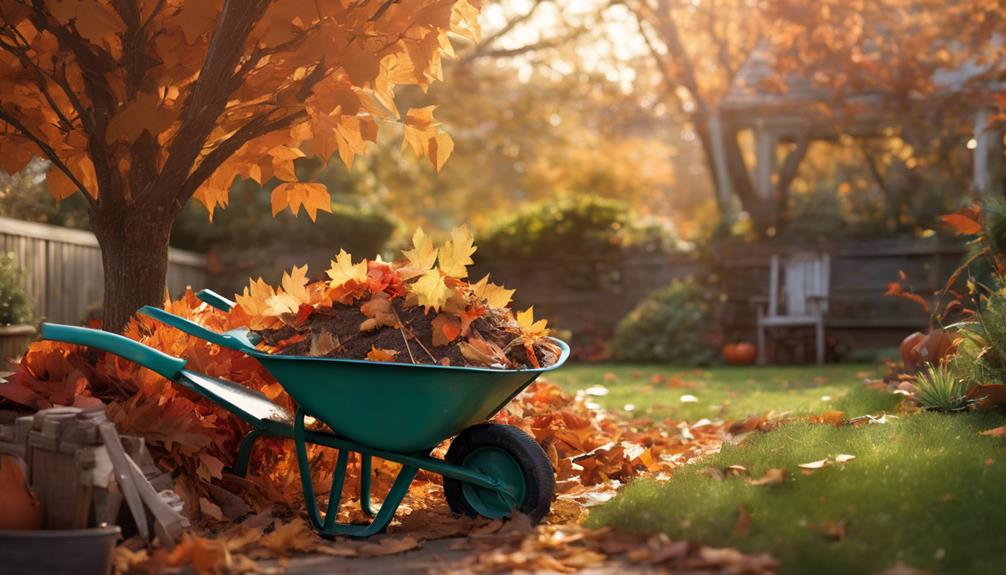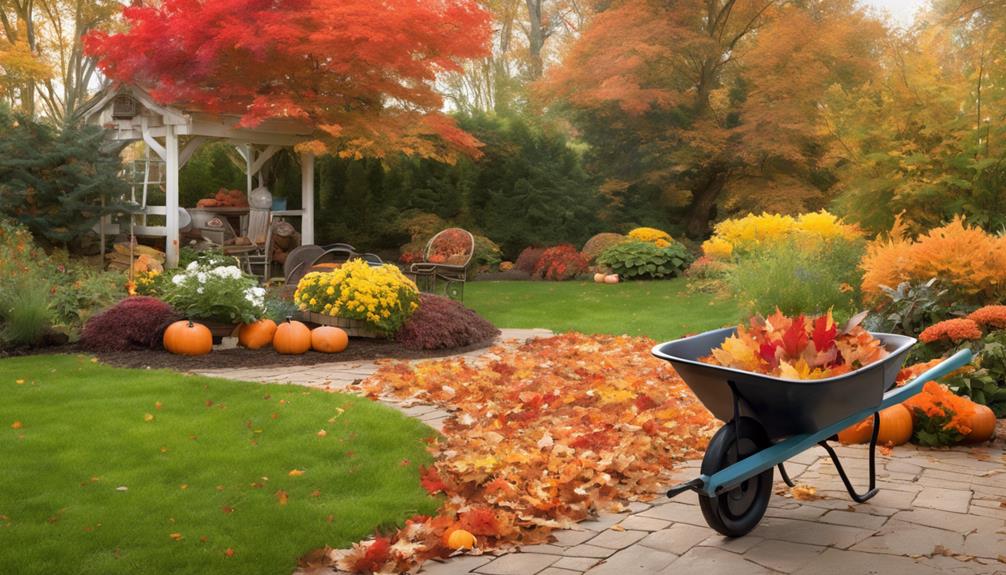
What Are Fast Lawn Care Tips for Busy People?
15 March 2025
Three Stylish Ideas for Modern Garden Design
15 March 2025A seasonal garden cleanup checklist is essential for enhancing plant health and optimising soil quality. It provides guidance on fundamental practices such as pruning, soil testing, and efficient pest management.
By systematically removing debris and dead plants, you improve nutrient accessibility and reduce competition for resources. This preparation increases crop yield potential and supports plant resilience against pests.
Furthermore, a well-organised checklist ensures timely actions, fostering a thriving and aesthetically pleasing garden. With each step, you lay the foundation for successful gardening in the upcoming seasons.
To explore further strategies for effective garden maintenance, consider the following insights.
Seasonal Garden Maintenance Essentials
Effective seasonal garden maintenance hinges on two critical practices: pruning and soil preparation.
Proper pruning techniques not only improve the health and aesthetics of plants but also promote robust growth.
Meanwhile, preparing the soil ensures ideal nutrient availability, setting the foundation for a thriving garden throughout the seasons.
Pruning and Trimming Techniques
Pruning and trimming are essential practices in seasonal garden maintenance that promote healthy growth and improve the overall aesthetics of your landscape.
Effective pruning involves removing dead, damaged, or diseased branches, thereby enhancing air circulation and light penetration. Utilise clean, sharp tools to make precise cuts, ensuring minimal injury to the plant.
Timing is important; late winter or early spring is often ideal for many species, while flowering plants may require post-bloom pruning to avoid disrupting the next season's display.
Trimming, on the other hand, fine-tunes the shape and size of shrubs, fostering a more polished appearance.
Soil Preparation Tips
After completing the pruning and trimming of your plants, attention must shift to the foundation of your garden: the soil. Effective soil preparation is crucial for robust plant growth and resilience.
Begin by testing your soil's pH and nutrient levels to identify deficiencies. Amend the soil with organic matter, such as compost or well-rotted manure, to improve its structure and fertility.
Tilling the soil will aerate it, promoting root penetration and water absorption. Furthermore, consider incorporating mulch to retain moisture and suppress weeds.
Lastly, allow the soil to rest and settle before planting, ensuring that it is well-prepared to support the health and vigour of your garden throughout the growing season.
Master these techniques for ideal results.
Plant Health and Soil Quality
Maintaining plant health and soil quality is crucial for a thriving garden.
Effective strategies such as mulching for moisture retention, implementing pest control measures, and seasonal pruning techniques can greatly improve plant vitality and soil structure.
Mulching for Moisture Retention
One of the most effective strategies for enhancing plant health and soil quality is the application of mulch, which plays an important role in moisture retention.
By creating a protective layer over the soil, mulch significantly reduces water evaporation and maintains consistent moisture levels, benefiting plant roots. This practice not only conserves water but also promotes a healthier soil ecosystem.
Key benefits of mulching include:
- Moisture Conservation: Reduces the need for frequent watering.
- Temperature Regulation: Keeps soil cooler in summer and warmer in winter.
- Weed Suppression: Minimises competition for nutrients and water.
- Soil Enrichment: Organic mulches decompose, enhancing soil fertility.
Implementing mulching techniques effectively safeguards plant health and optimises soil conditions.
Pest Control Strategies
Effective pest control strategies are essential for maintaining plant health and enhancing soil quality, as pests can severely impact both.
Implementing a comprehensive approach allows gardeners to mitigate infestations while promoting a thriving ecosystem.
Key strategies include:
- Integrated Pest Management (IPM): Utilise a combination of biological, cultural, and physical controls to reduce pest populations sustainably.
- Regular Monitoring: Conduct frequent inspections to identify pest activity early, enabling timely interventions.
- Beneficial Insects: Introduce natural predators, such as ladybirds and lacewings, to control pest populations without harmful chemicals.
- Healthy Soil Practices: Promote soil health through composting and crop rotation, which can strengthen plant resilience against pests.
Seasonal Plant Pruning Techniques
Pruning is a vital practice that directly influences plant health and soil quality, particularly as the seasons change. Proper pruning techniques not only enhance the aesthetic appeal of your garden but also contribute to the health of plants and the overall ecosystem.
Seasonal pruning assists in the removal of dead or diseased wood, facilitating improved air circulation and sunlight penetration, which promotes healthier growth.
- Timing: Prune at the appropriate time for each species to encourage vigorous growth.
- Technique: Utilise clean, sharp tools to make precise cuts, minimising damage.
- Shape: Maintain a balanced structure to support robust development.
- Focus: Prioritise the removal of crossing branches to prevent the spread of disease.
Implementing these techniques will ensure your garden flourishes throughout the seasons.
Garden Cleanup Checklist Steps
As the gardening season comes to a close, it is crucial to assess the readiness of your gardening tools to ensure peak performance for future tasks.
Furthermore, conducting soil tests will help determine nutrient levels, allowing for informed decisions on amendments and planting strategies.
Ultimately, considering companion planting can enhance garden productivity and pest management in the upcoming season.
Assessing Garden Tools Readiness
Preparation is key to a successful garden tidy-up, and evaluating the readiness of your garden tools plays a crucial role in this process.
Begin by conducting a thorough inspection of each tool, ensuring they are in peak condition to perform their tasks effectively.
Consider the following aspects during your assessment:
- Sharpness: Verify that the blades on pruners and shears are sharp for clean cuts.
- Functionality: Check that all moving parts operate smoothly without obstruction.
- Cleaning: Remove any debris or rust to prevent contamination and deterioration.
- Storage: Organise tools in a designated area, ensuring they are readily accessible and protected from the elements.
Soil Testing for Nutrient Levels
Regular soil testing is vital for maintaining a healthy garden ecosystem, as it provides valuable insights into the nutrient levels present in your soil.
By understanding these levels, you can make informed decisions about amendments and adjustments needed for optimal plant growth.
Consider the following key aspects of soil testing:
- pH Levels: Evaluating acidity or alkalinity to determine nutrient availability.
- Macronutrients: Analysing nitrogen, phosphorus, and potassium concentrations for balanced growth.
- Micronutrients: Testing for important trace elements such as iron and magnesium.
- Organic Matter: Measuring humus content to improve soil structure and fertility.
Incorporating soil testing into your seasonal garden clean-up checklist will enhance your gardening success and foster a thriving landscape.
Companion Planting Strategies
Companion planting is an essential strategy for maximising garden health and productivity, often involving the strategic placement of complementary plants to improve growth and deter pests.
This method not only boosts biodiversity but also promotes a sustainable gardening ecosystem.
To effectively implement companion planting, consider the following strategies:
- Pairing Nitrogen-fixers: Plant legumes alongside leafy greens to enrich soil nutrients.
- Pest Deterrence: Use marigolds to repel nematodes when planted near tomatoes.
- Attracting Beneficial Insects: Incorporate flowers such as dill or fennel to attract pollinators and predatory insects.
- Maximising Space: Utilise vertical growing techniques by pairing tall plants with low-growing companions for efficient light usage.
Increased Crop Yield Potential
Many gardeners strive to optimise their harvests each growing season, and effective seasonal cleanup plays a vital role in achieving increased crop yield potential. By meticulously removing debris and dead plants, gardeners can enhance soil health, ensuring that nutrients are readily available for crops. Furthermore, a clean garden reduces competition for resources, allowing desired plants to thrive.
| Benefit | Description | Impact on Yield |
|---|---|---|
| Soil Aeration | Improves root growth | Higher yields |
| Disease Prevention | Reduces pathogens | Healthier plants |
| Nutrient Availability | Increases access to crucial nutrients | Increased production |
| Pest Control | Minimises pest habitats | Less crop loss |
| Improved Sunlight | Optimises light penetration | Greater photosynthesis |
Embracing a seasonal cleanup is a critical step towards mastery in gardening.
Pest Management Techniques
Effective pest management is essential for maintaining a healthy garden ecosystem.
Techniques such as the application of neem oil, the release of beneficial insects, and the use of beneficial nematodes can greatly reduce pest populations while promoting plant health.
Implementing these strategies not only protects your crops but also fosters a naturally balanced environment.
Neem Oil for Pest Control
Regularly employing neem oil as a pest control solution is a sustainable approach favoured by many gardeners. Extracted from the seeds of the neem tree, this natural pesticide disrupts the life cycle of various pests, minimising their impact without harming beneficial insects.
Its efficacy is attributed to active compounds that target the hormonal systems of insects, preventing growth and reproduction.
Key benefits of using neem oil include:
- Broad-spectrum effectiveness against aphids, mites, and whiteflies.
- Minimal toxicity to mammals and beneficial organisms.
- Fungicidal properties, aiding in the prevention of plant diseases.
- Long-lasting residual effects, offering extended protection.
Incorporating neem oil into your pest management strategy can lead to healthier plants and an eco-friendly gardening approach.
Beneficial Insect Release
The release of beneficial insects is a powerful and natural pest management technique that promotes ecological balance within the garden.
By introducing these predatory or parasitic insects, gardeners can effectively manage pest populations without relying on chemical interventions. This sustainable approach not only protects valuable crops but also enhances biodiversity.
- Ladybirds: Efficient aphid predators that can considerably reduce infestations.
- Lacewings: Their larvae feed on a variety of soft-bodied pests, including thrips and spider mites.
- Parasitic Wasps: Target specific pest species, laying eggs within them, which helps control their numbers.
- Predatory Mites: Effective against spider mites and other pest mites, maintaining a healthy plant environment.
Implementing the release of beneficial insects fosters long-term pest management solutions.
Beneficial Nematode Application
Utilising beneficial nematodes as a pest management technique can greatly improve soil health while controlling harmful insect populations.
These microscopic roundworms target soil-dwelling pests such as grubs and root weevils, effectively disrupting their life cycles without harming beneficial organisms.
When applying beneficial nematodes, consider the following:
- Timing: Apply during ideal soil temperatures (15-29°C) for maximum efficacy.
- Moisture: Ensure the soil is moist before and after application to facilitate nematode movement.
- Concentration: Use the appropriate nematode density for your specific pest issue.
- Compatibility: Assess potential interactions with other pest management methods to guarantee synergistic effects.
Weeds and Their Management
Effective weed management is essential for maintaining a healthy garden and optimising plant growth.
Strategies such as mulching to suppress weeds, enriching soil with compost, and applying organic fertilisers can greatly improve the garden's health while minimising weed competition.
Mulching to Suppress Weeds
Mulching serves as a fundamental strategy in weed management, providing a protective barrier that inhibits the growth of unwanted plants while improving soil health. The application of mulch effectively reduces the sunlight available to weeds, thereby limiting their ability to germinate and flourish.
Furthermore, organic mulches contribute to moisture retention and temperature regulation within the soil, fostering an ideal environment for desirable plants.
- Improves soil moisture retention
- Regulates soil temperature
- Suppresses weed growth effectively
- Enhances soil structure over time
Selecting the appropriate type of mulch—whether organic or inorganic—can greatly impact the efficacy of this practice.
Regular maintenance and replenishment of mulch are imperative to ensure sustained weed suppression and holistic garden vitality.
Compost for Soil Enrichment
Compost serves as a formidable ally in enhancing soil health and fertility, significantly aiding in effective weed management. By improving soil structure and nutrient content, compost fosters an environment that encourages healthy plant growth while suppressing weed proliferation.
Strategically utilising compost can lead to a more robust ecosystem in your garden.
- Encourages beneficial microorganisms that outcompete weeds
- Boosts moisture retention, thereby reducing weed germination
- Provides essential nutrients, promoting vigorous plant growth
- Improves soil aeration, which discourages weed establishment
Incorporating compost into your garden not only enriches the soil but also diminishes the need for chemical herbicides, resulting in a more sustainable and productive gardening experience.
Mastery of composting techniques will empower you to cultivate a thriving, weed-resistant garden.
Organic Fertilizer Application Techniques
Applying organic fertilisers effectively can significantly enhance plant health while simultaneously combating weed growth. By employing specific application techniques, you can ensure that nutrients reach the desired plants while minimising the proliferation of weeds.
- Targeted Application: Apply fertilisers directly at the base of plants to avoid nourishing weeds.
- Timing: Fertilise during the active growth periods of your plants, but when weeds are less active, such as early spring or late autumn.
- Mulching: Utilise organic mulches to suppress weed growth while enriching the soil as they decompose.
- Soil Testing: Conduct soil tests to ascertain nutrient deficiencies, allowing for a precise approach in fertiliser application.
Why Choose TKL Birmingham Gardener
When it comes to maintaining a vibrant and healthy garden, choosing the right gardening service can make all the difference. TKL Birmingham Gardener stands out for its commitment to excellence, tailored solutions, and extensive expertise.
Our team of skilled horticulturists utilises cutting-edge techniques and sustainable practices, ensuring optimal growth and resilience for your garden. We prioritise understanding your unique landscape needs, enabling us to deliver customised care that enhances the aesthetic and ecological value of your outdoor space.
With a proven track record of satisfied clients, TKL Birmingham Gardener combines professionalism with a passion for gardening, ensuring your seasonal cleanup and ongoing maintenance are executed with precision.
Choose us for a garden that not only flourishes but also reflects your personal style and vision.
Common Gardening Questions Answered
Gardening often raises a variety of questions, from plant care to pest management, as enthusiasts seek to cultivate thriving landscapes.
One common inquiry pertains to soil health; understanding soil composition and pH is essential for optimal plant growth.
Furthermore, many gardeners wonder about the best practices for watering—striking a balance between under and over-watering is critical.
Pest control is another frequent concern, with organic and chemical options available; knowing when to intervene can prevent infestations.
Seasonal plant selection also prompts questions, as choosing the right species for the climate guarantees robust development.
Finally, pruning techniques are often debated, with timing and methods affecting the overall health and aesthetics of plants.
Mastery in these areas leads to flourishing gardens.
Plan for Seasonal Transitions
As seasons change, it is crucial to adapt your gardening strategies to ensure a smooth transition for your plants.
Planning for seasonal shifts not only enhances plant health but also optimises garden productivity. A meticulous approach guarantees that flora can withstand the varying climatic conditions throughout the year.
- Assess soil health and amend as necessary.
- Rotate crops to prevent soil depletion and pest build-up.
- Adjust watering schedules to align with seasonal moisture levels.
- Prune and deadhead plants to encourage robust growth.




